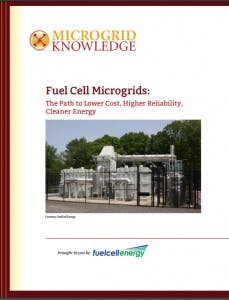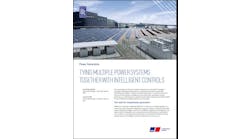Businesses and institutions install fuel cell microgrids for many reasons. Driving down energy costs is a big one.
Special Report: “Fuel Cell Microgrids: The Path to Lower Cost, Higher Reliability, Cleaner Energy“
Here we look at three ways fuel cell microgrids create financial advantage:
- By competing with utility pricing
- Through favorable financing models that reduce customer risk
- In achieving efficiencies through use of combined heat and power (CHP) and advanced microgrid controls
Fuel cell capital costs have dropped steeply in recent years, with increased production and economies of scale, according to Navigant Research. In fact, prices fell more quickly for stationary fuel cells than they did for wind energy and at about the same pace as solar energy, a trend Navigant sees continuing.
Lower unit costs contribute to quicker payback on the capital investment of installing a fuel cell microgrid. Larger macro-economic trends also are making fuel cells more advantageous, particularly historically low natural gas prices. Natural gas is a commonly used feedstock in the clean electro-chemical process fuel cells use to generate energy.
Not surprisingly, fuel cells offer the greatest cost advantage in parts of the country where utility prices are high. So fuel cell installations are apt to be found in the U.S. Northeast, California and Hawaii, where businesses pay 10 to 20 cents/kWh or more for electricity, double-to-triple the price in lower-cost states. Meanwhile, the fuel cell can produce electricity for the customer for 8 to 14 cents/kWh, according to FuelCell Energy.
FuelCell Energy says a 20 percent cost savings is common for fuel cell customers in these regions. Using a 1.4 MW fuel cell, the customer is likely to save $100,000 for every one penny spread between the fuel cell and grid power costs.
Reducing risk
Risk is often a concern for businesses and institutions that are considering making a large capital outlay on energy equipment. Money spent on energy infrastructure may mean money not spent on core operations or expansion.
The growing use of power purchase agreements (PPA) helps avert this risk. These no-money-down approaches offer monthly electricity prices at or below what the customer would otherwise pay for grid power. At the same time, the customer gains the benefits of reliable power and a cleaner environmental footprint.
Under a PPA model, the fuel cell company guarantees equipment performance, and may serve as operator of the fuel cell, handling all logistics and maintenance. So the customer is spared both financial and operational risk.
Evaluating pricing
PPA prices are largely fixed, although fuel costs may vary over the lifetime of the contract (typically 20 years). Customers considering long-term price differentials should evaluate forecasts for the fuel used by their system because long-term pricing appears favorable for fuel cells that use natural gas. The U.S. Energy Information forecasts that natural gas prices will remain “relatively low” through 2040 in its Annual Energy Outlook 2017.
Companies considering a fuel cell PPA also should look at price forecasts for grid power, and see how they compare to their contract. Grid power prices have historically risen in the United States. Governed by state regulatory agencies, utility prices do not necessarily reflect fuel prices alone—as changes in a fuel cell contract might. Instead, utility prices can also be influenced by a utility’s need to build new infrastructure, comply with regulatory mandates and other factors.
Prices fell more quickly for stationary fuel cells than they did for wind energy and at about the same pace as solar energy…
Additionally, only about a third of the cost of generating electricity using a fuel cell comes from fuel costs; the other two thirds are operations and maintenance costs and plant costs, both of which are fixed for the full term of the PPA. This is why a fuel cell PPA can result in not only much lower utility costs to a business owner than continuing to buy power from the electric grid, but less business cost volatility as well.
EIA forecasts gradual electricity price increases through 2040. In evaluating pricing, fuel cell customers also should take into account heat efficiencies they can achieve if they use a fuel cell in conjunction with combined heat and power (CHP). These units capture waste heat created as a byproduct of electric generation. Ordinarily, this heat would be wasted, dispersed into the air or water. Instead, it is used to heat or cool customer facilities or provide useful steam. So, CHP systems create a kind of two-fer; from one fuel source, they create two forms of energy. Companies using CHP can cut costs of on-site boilers and related fuel contracts.
Advanced microgrid controllers can further leverage CHP, as well as other resources within the microgrid. The controllers can discern which combination of resources should be used at any given time to achieve best pricing. The controllers can leverage not only generators and energy storage within the microgrid, but also power from the central grid.
Incentives to offset costs
Finally, it’s important to note that many states offer financial incentives to encourage fuel cell use. These come in many forms, from grants and loans to allowing fuel cells to produce various kinds of renewable energy credits. Utilities and competitive retail suppliers buy the credits to meet state clean energy requirements.
In all, 30 states include fuel cells or hydrogen under their Renewable Portfolio Standards, 25 help fund fuel cells through rebates, grants, loans or other assistance and 16 offer tax incentives, according to the Fuel Cell and Hydrogen Energy Association (FCHEA).
Examples of State Support
Connecticut
Connecticut created the Microgrid Grant and Loan Program to spur fuel cell use. The state also offers fuel cell incentives through its Low-Emission Renewable Energy Credits Program (LREC). Fuel cells can generate Class I renewable energy credits in the state, which can be sold to utilities and Independent Power Producers (IPPs) under long-term contracts.
California
Since 2001, more than 400 fuel cells systems have been installed through California’s Self-Generation Incentive Program (SGIP). The total SGIP fuel cell capacity is more than 175 MW, with funding requiring increasingly more efficient, low greenhouse gas emissions installations.
New York
The New York State Energy Research and Development Authority made $150 million in funding available for large-scale renewable energy projects to help the state meets its goal of 50% renewable electricity by 2030. Fuel cells are included with contracts awarded for a term of up to 20 years.
New Jersey
New Jersey’s Clean Energy Program offers an incentive for fuel cells with heat recovery with an installed capacity greater than 3 MW.
Source: FCHEA
Read more about the rise of fuel cell microgrids in our report, “Fuel Cell Microgrids: The Path to Lower Cost, Higher Reliability, Cleaner Energy,” downloadable at no cost, courtesy of FuelCell Energy.
[clickToTweet tweet=”Three Ways Fuel Cell #Microgrids Lower Energy Cost” quote=”Three Ways Fuel Cell Microgrids Lower Energy Cost”]







